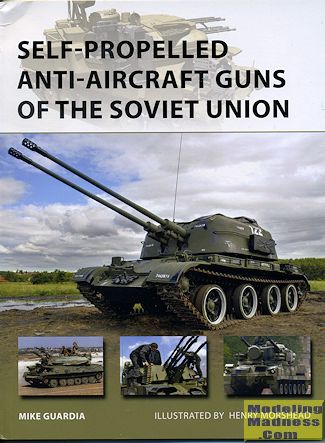 Though
not a specific result of the events of WWII, it was during that conflict that
the Self-Propelled Anti-Aircraft Gun (SPAAG), really took hold. The Germans
probably had the widest variety of these vehicles with some mounted on
half-tracks and others on tank chassis. These vehicles generally had weapons in
either the 20mm or 37mm range. They were not designed for high-flying bombers,
the 88s and later guns could deal with those and those guns were not all that
mobile due to their size. No, the German SPAAG was more to defend mobile armies
from low flying fighter bombers.
Though
not a specific result of the events of WWII, it was during that conflict that
the Self-Propelled Anti-Aircraft Gun (SPAAG), really took hold. The Germans
probably had the widest variety of these vehicles with some mounted on
half-tracks and others on tank chassis. These vehicles generally had weapons in
either the 20mm or 37mm range. They were not designed for high-flying bombers,
the 88s and later guns could deal with those and those guns were not all that
mobile due to their size. No, the German SPAAG was more to defend mobile armies
from low flying fighter bombers.
The British, Soviets and Americans also had similar vehicles, though not
in the variety of the Germans. The Allies in the west also did not face the sort
of opposition in terms of ground attack as the Soviets and most of these
vehicles were pretty much machine gun armed.
After WWII, most Allied nations gave up on the idea of a SPAAG. There
were prototypes developed, but other than the M-42 'Duster', little came of
these in terms of production vehicles. Even the Duster was retired in the late
1950s as it was felt that jet aircraft were simply too fast to knock down. It
was the Soviets who grabbed the SPAAG ball and ran with it.
Their first SPAAG was the ZSU-37 (the main cover image), equipped with
two 37mm guns and mounted on a SU-76 chassis. This was developed during the war
and was just too late to be useful as by the time it entered service, the
Luftwaffe was no longer a threat. This vehicle was upgraded to a T-54 chassis
and was widely produced, seeing action with Soviet client states well into the
1980 with a few still in service.
A major drawback of the ZSU-37 was a lack of range, a lack of weight of
fire and the lack of radar tracking. The next vehicle, the ZSU-23-4. This had
four 23mm cannon, was mounted on a newer chassis and had radar guidance. Of
course, it wasn't perfect, but it provided a greater weight of fire from its
four, faster firing guns and was more able to track faster aircraft.
This gun was far more useful than the previous version and went through
considerable upgrading over the years. It is still in active service with
Russian and former Russian as well as ex-Warsaw pact nations and client nations.
One of the upgrades that some nations have made is to add SAM missiles to the
vehicles, providing greater protection against all sorts of aerial threats.
Adding SAMs to the usual gun armament has resulted in the latest Russian
vehicle, the 9K22 Tunguska. Though technically not a SPAAG as it probably relies
more on its missiles than guns, it is included in this book as it is the logical
successor to the ZSU-23-4. Like its predecessors, this vehicle has seen action
in recent years, most recently in the Russian invasion of the Crimea and
probably during fighing in eastern Ukraine.
The author covers the history of each of these vehicles, including
upgrades and their use in combat during various conflicts since the end of WWII.
A very nice selection of period photos has been included with many of the newer
images in full color. This has been enhanced by the art work of Henry Morhead.
In all, it makes for an excellent reference on the type and a fine addition to
the series. It is a book I liked reading and from which I learned quite a bit.
Highly recommended.
May 2015
For more on the complete line of Osprey books,
visit http://ospreygrp.com. In the US, it is
Osprey Direct at 44-02 23rd St, Suite 219, Long Island City, NY 11101., where you can
get a catalogue of available books.
If you would like your product reviewed fairly and
fairly quickly, please
contact
the editor or see other details in the
Note to
Contributors.
 Though
not a specific result of the events of WWII, it was during that conflict that
the Self-Propelled Anti-Aircraft Gun (SPAAG), really took hold. The Germans
probably had the widest variety of these vehicles with some mounted on
half-tracks and others on tank chassis. These vehicles generally had weapons in
either the 20mm or 37mm range. They were not designed for high-flying bombers,
the 88s and later guns could deal with those and those guns were not all that
mobile due to their size. No, the German SPAAG was more to defend mobile armies
from low flying fighter bombers.
Though
not a specific result of the events of WWII, it was during that conflict that
the Self-Propelled Anti-Aircraft Gun (SPAAG), really took hold. The Germans
probably had the widest variety of these vehicles with some mounted on
half-tracks and others on tank chassis. These vehicles generally had weapons in
either the 20mm or 37mm range. They were not designed for high-flying bombers,
the 88s and later guns could deal with those and those guns were not all that
mobile due to their size. No, the German SPAAG was more to defend mobile armies
from low flying fighter bombers.